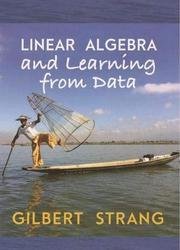Linear Algebra and Learning from Data
- Добавил: literator
- Дата: 12-08-2020, 15:22
- Комментариев: 0
 Название: Linear Algebra and Learning from Data
Название: Linear Algebra and Learning from Data Автор: Gilbert Strang
Издательство: Wellesley-Cambridge Press
Год: 2019
Страниц: 449
Язык: английский
Формат: pdf (true)
Размер: 25.1 MB
This is a textbook to help readers understand the steps that lead to Deep Learning (DL). Linear algebra comes first especially singular values, least squares, and matrix factorizations. Often the goal is a low rank approximation A = CR (column-row) to a large matrix of data to see its most important part. This uses the full array of applied linear algebra, including randomization for very large matrices. Then Deep Learning creates a large-scale optimization problem for the weights solved by gradient descent or better stochastic gradient descent. Finally, the book develops the architectures of fully connected neural nets and of Convolutional Neural Nets (CNNs) to find patterns in data.
Linear algebra and probability/statistics and optimization are the mathematical pillars of Machine Learning (ML). We find it helpful to start with this description of the goal: To construct a function that classifies the training data correctly, so it can generalize to unseen test data. To make that statement meaningful, you need to know more about this learning function.
This book aims to explain the mathematics on which data science depends: Linear algebra, optimization, probability and statistics. The weights in the learning function go into matrices. Those weights are optimized by "stochastic gradient descent". That word stochastic ( = random) is a signal that success is governed by probability not certainty. The law of large numbers extends to the law of large functions: If the architecture is well designed and the parameters are well computed, there is a high probability of success.
Please note that this is not a book about computing, or coding, or software. Many books do those parts well. And online help, from Tensorftow and Keras and Math Works and Caffe and many more, is an important contribution to data science.
Audience: This book is for anyone who wants to learn how data is reduced and interpreted by and understand matrix methods. Based on the second linear algebra course taught by Professor Strang, whose lectures on the training data are widely known, it starts from scratch (the four fundamental subspaces) and is fully accessible without the first text.
Скачать Linear Algebra and Learning from Data
Внимание
Уважаемый посетитель, Вы зашли на сайт как незарегистрированный пользователь.
Мы рекомендуем Вам зарегистрироваться либо войти на сайт под своим именем.
Уважаемый посетитель, Вы зашли на сайт как незарегистрированный пользователь.
Мы рекомендуем Вам зарегистрироваться либо войти на сайт под своим именем.
Информация
Посетители, находящиеся в группе Гости, не могут оставлять комментарии к данной публикации.
Посетители, находящиеся в группе Гости, не могут оставлять комментарии к данной публикации.
